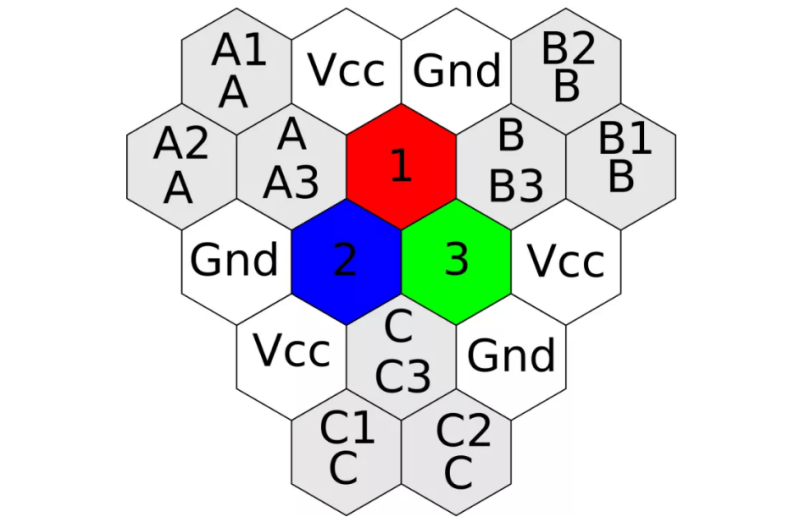A breadboard is a great prototyping tool for verifying the sanity of a circuit design before taking the painstaking effort of soldering it all together permanently. After all, a mistake in this stage can cost a lot of time and possibly material, so it’s important to get it right. [daverowntree] wasn’t fully satisfied with the standard breadboard layout though, with fixed rows and columns. While this might work for most applications, he tried out a new type of prototyping board based on hexagons instead.
The design philosophy here revolves around tessellations, a tiling method for connecting the various components on this unique breadboard rather than using simple rows. The hexagons are tessellated across the board, allowing for some unique combinations that might make it slightly more complicated, but can have some benefits for other types of circuits such as anything involving the use of a three-wire device like a transistor.
The post is definitely worth a read, as [daverowntree] goes through several examples of this method of prototyping where the advantages are shown, like a voltage follower circuit and some other circuits involving transistor biasing. If you’re OK with the general design of breadboards, though, and just wished you didn’t have to do anything after the prototyping stage, we’ve got some help for you there as well.
















Trying to work out if this is a late April Fool :-D
Appears to suffer greatly from scaling issues. Not going to see these as replacements any time soon.
Of course! Its scales horribly, has dreadful parasitics and area-efficiency, and should never ever be used for anything serious. It was supposed to be a fun thought-experiment. I saddens me that people interpret this as some new product idea or solution to all ills – it is not – it was a bit of fun! Jeez.
Yeah, right? We even put “crazy” in the title!
It’s a fun, if out-there, experiment. And that’s the whole point, right?
Because eff all those DIP, TSOP and whatever footprints. You’ll stick with two-pin SMT things, and you’re gonna like it! Well, one could maybe deadbug a component or two necessary, but you probably won’t want to go through that hassle too often.
I mean, he’s also pointing out a few other “tesselations”, and the square one -might- kinda work for your “normal” footprints, maybe… but… nah, I think I’ll pass, thanks.
Penrose tiling breadboard!
Ooh. I love Prof. Penrose’s work, so this is right up my street! I could make it even more inefficient and mental. Great suggestion :)
If it works for games, why not?
I think I’d rather deadbug than try to figure out how to get a circuit to fit into this pattern. Let’s face it: the attraction of the traditional breadboard is that pretty much all you have to do is plug in the DIP chips, and maybe leave a couple of empty slots between chips, and you can build pretty much anything.
In its form as presented, you also have to solder everything, which definitely loses compared with EITHER traditional breadboards or deadbug or manhattan techniques.
I was seriously looking into building a system I had when I was a teenager: an Knight-kit 100-in-one kit that used pegboard and plastic plugs with springs on top of them. All of the components were loose (except for panel mounted things like pots and variable capacitors, which were wired to springs bolted down to springs along the edge of the pegboard) and you plugged in these peg/spring things to mount the components on. Here’s what the working surface looks like; unfortunately it doesn’t have any components shown, just the springs connected to the panel-mounted components: https://thumbs.worthpoint.com/zoom/images3/1/0311/26/knight-kit-allied-100-electronic_1_093a9ece7895235e12ddc6e91ce48b0c.jpg
Like breadboards, the springs could accept a number of leads, but the freedom of the pegboard allowed laying it out like a schematic. Anyway, I thought this would be a good use to put my filament printer to, making the plastic pegs. Alas, I discovered that plain old springs are ridiculously expensive, like around $0.25-0.50 EACH. Stainless steel spring wire wasn’t much better.
Last year I needed some breadboards and went another way. 8×16 size holes plated through and smaller holes in between, you can add others in X and Y, and in 0.8mm thickness – so you can break them easily – 100 of them for $30 in China within 3 weeks – need more soon and will add an SOP footprint this time for Tiny13, Tiny84/85 and hopefullt 328 – unconnected.
I’m having trouble visualizing this. Can you post a picture or Gerber files?